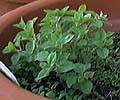
Subject: Marjoram
Date: Fri, 10 Aug 2001 22:04:54 +0100 ***
COMMON NAME (English/German): marjoram
LATIN NAME: origanum majorana
TYPE OF PLANT: "tender" perennial
SYMBOLISM: joy
MYTHS/LEGENDS: Wreaths and garlands of marjoram were used at Greek
weddings and funerals. Said to comfort the dead when it grew on their
graves. Young Greek couples were crowned with it at their weddings.
If you anoint yourself with it before sleeping, you will dream of
your future spouse.
MAGICKAL: Sacred to Aphrodite
- MEDICINAL: minor antioxidant and antifungal properties;
gargles and teas may relieve sinus congestion and hay fever; may
irritate the uterus if used during menstruation or pregnancy.
- bath: relieves aches, chest congestion; mildly antiseptic
properties benefit skin
-
- EDIBLE: Similar to oregano.
- Herb butter blend--marjoram and garlic.
- Tea blend--marjoram, anisse and lemon verbena
CULTIVATION
- zones: 9-10
- soil pH and composition: light, pH 6.9
- planting time: after danger of frost has passed
- bloom time: August-September
- sun and water: full sun, dry, well-drained
- companions:
HARVESTING AND STORAGE: Dry away from sunlight to preserve color
and flavor. Rub stems on a screen to shred the leaves, then discard
the stems. Store in airtight containers.
ETC.: green dye; air freshener; good for potpourri

Subject: Mint
Date: Fri, 10 Aug 2001 22:21:17 +0100 ***
COMMON NAME (English/German): mint/münze (?)
LATIN NAME: Mentha
TYPE OF PLANT: perennial
SYMBOLISM: refreshment, hospitality
MYTHS/LEGENDS: When Persephone found out that Pluto was in love
with the beautiful nymph Minthe, jealousy burned within her, and she
changed Minthe into a lowly plant. Pluto couldn't undo Persephone's
spell, but he did soften it a little so that the more Minthe was
tread upon, the sweeter her smell would be.
The Pharisees paid their tithes with mint. The Roman scholar Pliny
wrote: "The very smell of it reanimates the spirit." The Greeks used
mint in various herbal treatments and temple rites.
- MEDICINAL: Used for chills, cold/flu, upset stomach,
flatulence, abdominal pain/cramps, nausea, insomnia, headache,
toothache, bad breath, chapped hands, sore mouth/throat,
beestings/insect bites.
- bath: Any mints used in a bath will be stimulative and
restorative.
- cosmetic: Soak a cup of fresh peppermint or spearmint leaves
in a quart of cold water, strain and chill. Use this mint water to
wash your face.
- EDIBLE: Young leaves taste better. Use the older, bitter
leaves for crafts. Can be used a gagillion ways, but most popular
in drinks.
- Herb vinegar--mint, honey, cardmom seed with white vinegar.
- Herb butter--mint and dill.
- Tea blends: lemon balm, spearmint and elderberry; pennyroyal,
peppermint and ginger
CULTIVATION
- zones: 5
- soil pH and composition: rich, pH 6.5
- planting time:
- bloom time: July-August
- sun and water: full sun to partial shade, moist, well-drained
- companions/threats: Benefits cabbage and tomato. Repels
ants,aphids, cabbage looper, cabbage worm, flea beetle, squash
bug, whitefly. Susceptible to mint rust, spider mites, loopers,
mint flea beetles, mint root borers, grasshoppers, cutworms, root
weevils and aphids.
HARVESTING AND STORAGE: Fresh is best; dried or frozen is a close
second.
ETC.: great for potpourri; repels rodents
top of page

***Excerpted from my original
contributions to an online discussion graciously sponsored by
Dracona Pagan
Web. {back}
http://www.moonchild.ch/Journal/garden/herbM.html